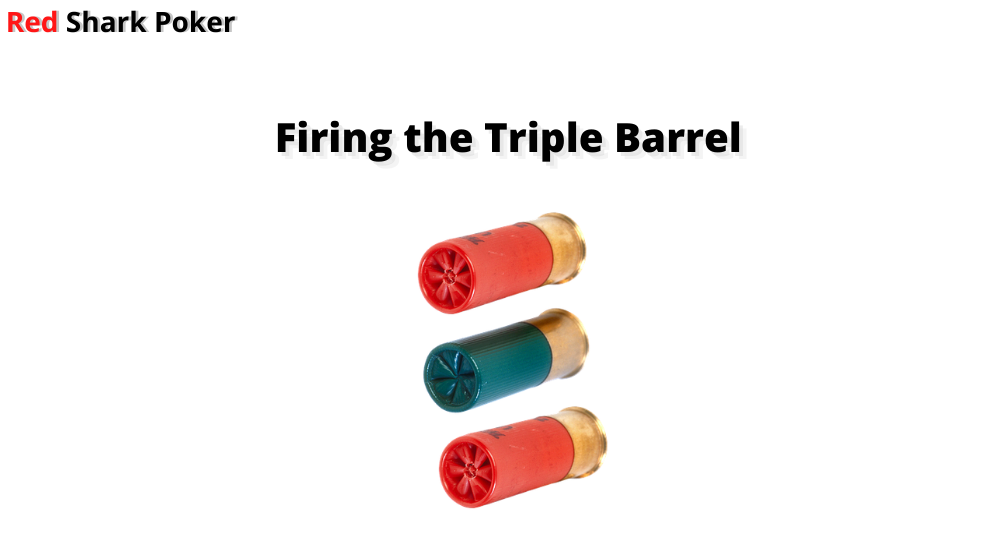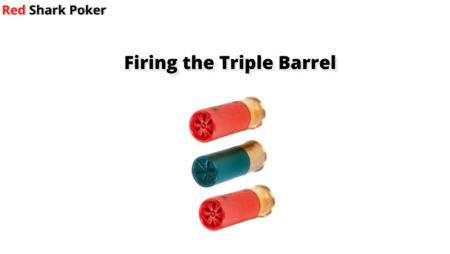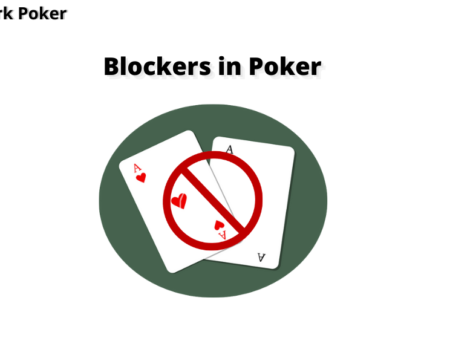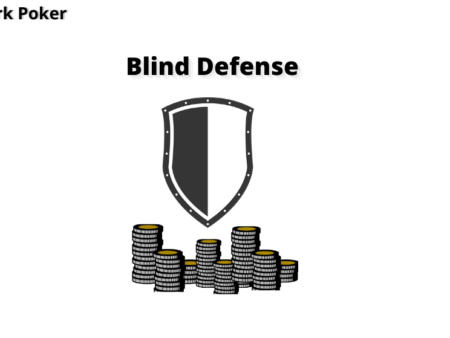

You made a cbet on a missed flop, and your opponent called. You miss on the turn again and fire the double barrel hoping your opponent will fold. But you still got called. What will you do now? Will you fire the third barrel on the river? This is where most of the players struggle – To fire the triple barrel or not! If you also face such a dilemma on the river, read this comprehensive chapter on when and how to fire the triple barrel in poker.
What is a Triple Barrel in Poker?
Triple barrelling is simply continuing your bluff on the river as a preflop raiser after you have bluffed on both the flop and the turn. If you raised preflop with A♠ K♠ and made a bet on a 9♦ 7♥ 3♣ flop, you have made a cbet on a missed flop. If you bet again on a 9♦ 7♥ 3♣ J♠ turn, you are bluffing on a missed turn. This is called firing a double barrel. If you bet on a 9♦ 7♥ 3♣ J♠ Q♦ river, you are basically bluffing or “firing a triple barrel”. The intent of triple barrelling in poker is to make your opponent fold on the river.
Preflop Raise –> Cbet –> Double Barrel –> Triple Barrel
When you are firing the triple barrel, you are basically bluffing on all the streets post-flop – The Flop, the Turn and the River. Most of the players are scared to fire the triple barrel on the river after their opponent call on the turn. When you miss the river as well, the only way to win the pot is by forcing your opponent to fold by firing a triple barrel. Let’s see which situations are conducive for you to fire the third barrel.
Fire the Right Double Barrel First
A good double barrel leads to a successful triple barrel. You must know on which board textures you should double barrel before planning on firing the third barrel. You should opt to double barrel when an overcard hits on the turn. Such cards help to strengthen your perceived range as a preflop raiser. Broadway cards or overcards fall within your range as a preflop raiser. Some of the best board textures where you can double barrel are as follows:
Dry Flop with a Broadway Card + Overcard on the Turn
Flop: K♣ 7♥ 3♦ | Turn: A♠
Flop: Q♥ 9♣ 5♠ | Turn: K♦
Flop: J♣ 7♦ 2♥ | Turn: Q♠
Dry Flop with No Broadway + Broadway on the Turn
Flop: 10♣ 5♥ 3♦ | Turn: K♠
Flop: 2♥ 9♣ 5♠ | Turn: Q♦
Flop: 8♣ 5♦ 2♥ | Turn: J♠
If you don’t know how to fire the double barrel, read this chapter: How to Fire the Double Barrel in Poker?
Basics of Triple Barrelling in Poker
Before you decide to triple barrel, make sure to follow certain basic rules to make your bluff effective. Your opponent, stack size and proper planning play an important role in determining the success of your third barrel in poker.
Enough Stack Size
You definitely need to have a stack big enough to fire a triple barrel. If you don’t have a stack big enough till the river, any bet size smaller than your double barrel will show weakness. You will have to go all-in with whatever chips you have left and end up giving good pot odds to your opponent. So, it is advised to have a full stack of 100 big blinds or more before you decide to triple barrel in poker.
Type of Opponent
It is imperative to know against whom you are playing before firing the triple barrel in poker. Big calling stations (Fish) and maniacs (LAGs) are the ones you should avoid barrelling with. These players usually don’t fold when they have a bottom or middle pair. And, most importantly, never try to bluff against an amateur player who can’t comprehend what you are representing. The best players to triple barrel would be weak tight-aggressive players (TAG) and super-tight players (NIT) who won’t risk a large portion of their stack unless they have the nuts. If you are using a HUD, look for WTSD stats (Went to Showdown) to see how likely they are going to the showdown. Also, check the Fold to Triple Barrel stats to see how many times they fold to a triple barrel.
Plan on Triple Barrelling on the Flop
When you don’t connect on the flop, make a plan on how big the pot will be if you decide to barrel on the later streets. If you make a cbet of 2/3 of the pot, how much are you willing to bet on the turn and on the river. Triple barrelling shouldn’t be a sudden move on the river if you don’t connect with the board. It should be a well-planned move on the flop itself so that you don’t give away any signs of weakness.
Is Your Story Making Sense?
The fundamental strategy behind executing a successful bluff is to make sure that your story makes sense. Since you are the preflop raiser, any card on the river that strengthens your perceived range helps you to pull off a successful bluff. The river card should make your range stronger and weaken your opponent’s range. If the river card is making your preflop range stronger, you will be able to tell a successful story with your triple barrel and force your opponent to fold.
When to Fire the Triple Barrel in Poker?
You need to consider a lot of factors like the ones mentioned above before triple barrelling in poker. However, you can check the following situations that are ideal for firing the third barrel.
When Your Opponent Misses His Draw
When your opponent calls on a wet turn, he is most likely to chase his draws. If the river does not help your opponent, you can choose to triple barrel. For example, if your opponent called on your double barrel on a 2♣ 3♥ 7♦ J♦, you can fire the triple barrel if Q♥ hits on the river. Your opponent hasn’t completed his flush draw or straight draw, and a triple barrel can force your opponent to fold.
When the River Card Strengthens Your Perceived Range
As you already have double barrelled on the turn based on the board texture, any card that further strengthens your perceived range helps in executing a successful bluff. Your table image also plays an important role here. If you are a tight-aggressive player, any river card that falls in your range will strengthen your perceived range. For example, if you double barrel on a T♣ 5♥ 3♦ J♦ turn, you are representing a pair of Jacks here. However, if your opponent called, he might be holding a pair of Tens on the flop or a pair of Jacks on the turn. If an A♠ hits on the river, it helps to strengthen your perceived range. As you are the preflop raiser, you can easily have AA, AK, KQ, AJ and AT. You can represent the top pair of aces, a straight with KQ, a set of aces, two pairs AA and AT, and the another two pairs AA and JJ.
Read: Detailed Chapter on How to Bluff in Poker
When Not to Fire the Triple Barrel in Poker?
Don’t think of firing the triple barrel in poker when the opposite of what was discussed above occurs. Triple barrel mostly fails in the following situations:
Low Cards on the River
Low cards or undercards that don’t help to strengthen your perceived range can prove to be costly if you triple barrel in poker. You are most likely to get called. Look at some of the examples below:
Turn: J♣ 5♥ 7♦ Q♣ | River: 2♠
Turn: Q♥ 9♣ 5♠ K♣ | River: 4♦
If your opponent called on the turn with any top or middle pair, they are not likely to fold to your triple barrel as these undercards don’t help to strengthen your range. Your opponent is more likely to call your third barrel.
Paired Board by the River
A paired board by the river is a bad spot to make a bluff. Look at some of the paired boards below:
Turn: J♣ 5♥ 7♦ Q♥ | River: J♠
Turn: Q♥ 9♣ 5♠ A♦ | River: 9♦
If the card on the river pairs with any card on the board, it is better not to triple barrel in poker. Your opponent might hit trips, and he can raise or go all-in. Also, if your opponent has a different pair, he will be having two pairs on the river. It will be very difficult for your opponent to fold a two pair. So, it is better to check or fold if you face a bet.
And, Most Importantly – Is the River Card Helping Your Opponent?
With all the theories and board textures aside, you first need to have a good read on your opponent. You must have some knowledge of the type of range your opponent is calling your double barrel. If your opponent is a loose-aggressive player who plays with a wide range of hands, any card that helps his wide range can spell trouble for you. For example, you double barrelled on a 2♣ 3♥ 9♦ Q♥ turn with K♦ 10♥ and a loose-aggressive player calls. The river card is an A♣. This overcard looks good for you to double barrel. However, you need to know if this card is helping you or your opponent. Is your opponent that kind of a loose player who calls with 45? If he is calling with a wide range of hands like 45, he has completed his straight. In the same situation, if you are up against a tight-aggressive player, an Ace is also within his range. So, having some knowledge of your opponent’s range is more important than just betting on the board texture that seems favourable to you.
Conclusion
To be very honest, firing the triple barrel takes guts. Firing the last barrel on the river after you have bluffed on the flop and turn is no child’s play. You must have a good read on your opponent and be really confident that he will fold to your third barrel. As the pot is already big by the turn, the last barrel will cost a significant portion of your stack. However, this should not scare you from firing the last shell, as bluffing will be the only way to win the pot. Plan about it on the flop, analyse the board texture, have a good read on your opponent and fire the last barrel with the right stack size. Good luck!




